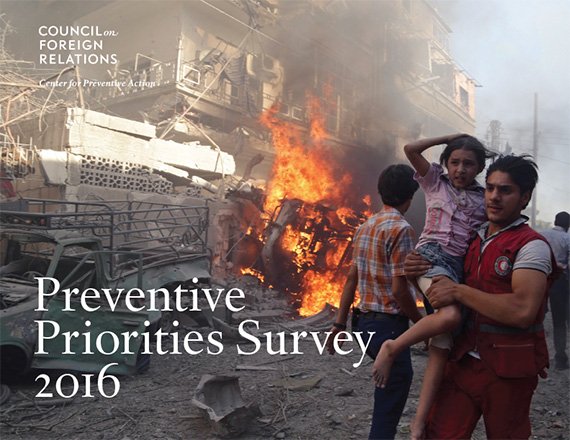
When it comes to global instability and conflict, the United States has plenty to be concerned about. World events will inevitably affect U.S. interests, which makes taking steps to recognize and reduce potential harm a top priority for the nation’s policymakers. The Council on Foreign Relations’ Center for Preventive Action (CPA) aims to clarify where the most urgent actions should be taken.
CPA’s annual Preventive Priorities Survey, supported by Carnegie Corporation, evaluates ongoing and potential conflicts around the world based on their likelihood of occurring in the coming year and their impact on U.S. interests. An initial list of 1,000 suggestions is crowdsourced from the general public, then narrowed to 30 contingencies. These are ranked by invited officials, academics, and foreign policy experts and rated Tier I, II, or III—from the most to the least threatening. The survey results are meant to help U.S. policymakers prioritize conflict prevention and crisis mitigation demands in the hope that early action will help avoid belated and costly responses.
What does the survey anticipate for 2016? The Middle East dominates this year’s results, occupying eight out of eleven Tier I slots and half of Tier II. Intensification of the Syrian civil war tops the list, and is the only contingency the survey judged to be highly likely to occur, and to dramatically affect the United States.
The remainder of Tier I includes (in brief):
- Mass casualty attack on the U.S. or a treaty ally
- Highly disruptive cyberattack on U.S. critical infrastructure
- Severe crisis with or in North Korea
- Political instability in EU countries stemming from the influx of refugees and migrants
- Continued political fracturing of Libya
- Heightened tensions between Israel and the Palestinian territories
- Intensified political violence in Turkey
- Increased political instability in Egypt
- Increased violence and instability in Afghanistan
- Continued fracturing of Iraq due to ISIS and Sunni-Shia violence
Tier II includes:
- Violence in Mexico
- Increased internal violence and political instability in Pakistan
- Increased sectarian violence and political instability in Lebanon
- Intensification of fighting in eastern Ukraine
- Growing political instability and civil violence in Jordan
- Intensified civil war in Yemen
- Potential confrontation between Iran and the United States or one of its partners or allies
- Armed confrontation in the East China Sea between China and Japan
- Armed confrontation over maritime areas in the South China Sea
- Increased tensions between Russia and NATO member states
Tier III includes:
- Severe India-Pakistan military confrontation
- Political instability in Saudi Arabia
- Intensified sectarian violence and political instability in Nigeria
- Escalation of Islamist militancy and violence in Russia
- Protracted civil war in South Sudan
- Escalation of sectarian violence in the Central African Republic
- Intensification of sectarian violence between Buddhists and Muslim Rohingyas in Myanmar
- Deepening economic crisis and political instability in Venezuela
- Growing political instability in the Democratic Republic of Congo
As the CPA admits, the results of the Preventive Priorities Survey represent the informed judgment of many experts, but these events are far from inevitable because, “The world is a dynamic place and thus assessments of risk and the ordering of priorities should be regularly updated.” To keep up with changing circumstances, see the Council on Foreign Relations’ interactive Global Conflict Tracker.
- Press Releases


